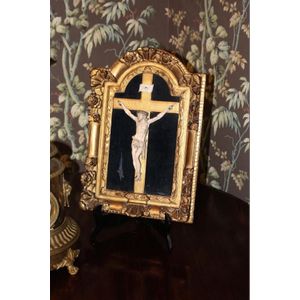French Ivory Crucifix on Gilt Wood Frame
Antique early 19th century French carved ivory crucifix of Christ, mounted on a gilt wood frame
You must be a subscriber, and be logged in to view price and dealer details.
Subscribe Now to view actual auction price for this item
When you subscribe, you have the option of setting the currency in which to display prices to $Au, $US, $NZ or Stg.
This item has been sold, and the description, image and price are for reference purposes only.
- Ivory - Ivory is a hard white material that comes from the tusks of elephants, mammoth, walrus and boar, or from the teeth of hippopotamus and whales. The ivory from the African elephant is the most prized source of ivory. Although the mammoth is extinct, tusks are still being unearthed in Russia and offered for sale.
Ivory has been used since the earliest times as a material for sculpture of small items, both in Europe and the east, principally China and Japan.
In Asia ivory has been carved for netsuke, seals, okimono, card cases, fan supports, animals and other figures and even as carved tusks.
In the last 200 years in Europe ivory has been used to carve figures, for elaborate tankards, snuff boxes, cane handles, embroidery and sewing accessories, in jewellery and as inlay on furniture. Its more practical uses include being used for billiard balls, buttons, and a veneers on the top of piano keys.
The use and trade of elephant ivory have become controversial because they have contributed to Due to the decline in elephant populations because of the trade in ivory, the Asian elephant was placed on Appendix One of the Convention on International Trade in Endangered Species (CITES), in 1975, and in January 1990, the African elephant was similarly listed. Under Appendix One, international trade in Asian or African elephant ivory between member countries is forbidden. Unlike trade in elephant tusks, trade in mammoth tusks is legal.
Since the invention of plastics, there have been many attempts to create an artificial ivory - Giltwood - Giltwood is used to describe a gold finish on furniture and other decorative wooden items, whereby a thin sheet of gold metal, called gold leaf, is applied to the surface for decorative purposes.
Unlike gilding, where the gold leaf is applied over a coating of gesso, with giltwood the gold leaf is applied direct to the surface, or over a coat of linseed oil gold leaf adhesive.
Most gold-finished mirrors will be gilded, whereas furniture with gold highlights will have the gold applied through the giltwood method.
This item has been included into following indexes:
-
religious objects, Christian
- crucifixes 128
- Jesus, items depicting 368
Visually similar items

19th century gilt framed overmantel mirror. Carved floral basket pediment; carved sides and corners. Height 76 cm. Width 56 cm
Sold by
in
for
You can display prices in $Au, $US, $NZ or Stg.

A ornately carved Italian wooden and gilded wall mirror. 180 x 87 cm.
Sold by
in
for
You can display prices in $Au, $US, $NZ or Stg.

'The Parrot' early German oil on tin, 20 x 15 cm
Sold by
in
for
You can display prices in $Au, $US, $NZ or Stg.

A Victorian mahogany and gilt wall mirror, 145 x 147 cm
Sold by
in
for
You can display prices in $Au, $US, $NZ or Stg.
